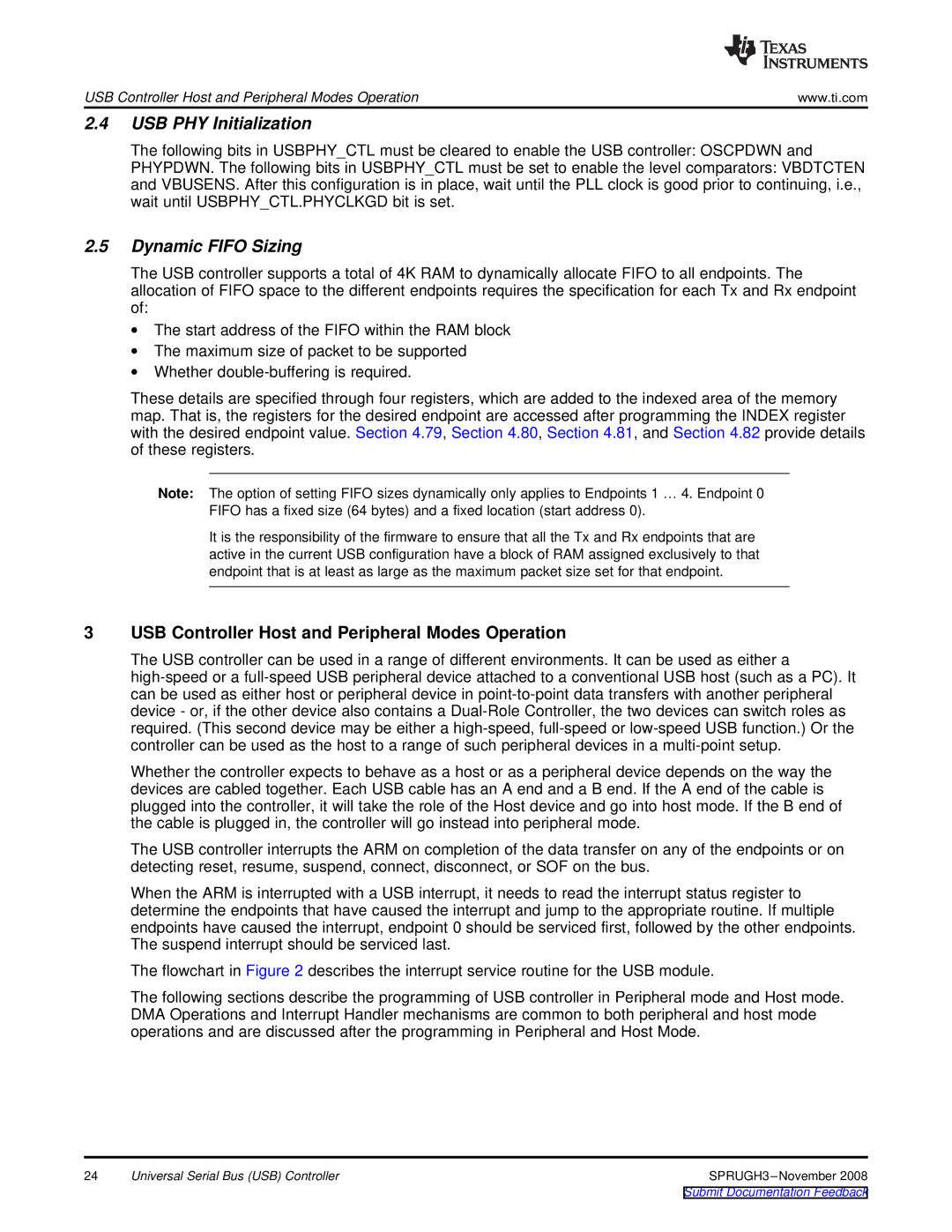
USB Controller Host and Peripheral Modes Operation | www.ti.com |
2.4USB PHY Initialization
The following bits in USBPHY_CTL must be cleared to enable the USB controller: OSCPDWN and
PHYPDWN. The following bits in USBPHY_CTL must be set to enable the level comparators: VBDTCTEN and VBUSENS. After this configuration is in place, wait until the PLL clock is good prior to continuing, i.e., wait until USBPHY_CTL.PHYCLKGD bit is set.
2.5Dynamic FIFO Sizing
The USB controller supports a total of 4K RAM to dynamically allocate FIFO to all endpoints. The allocation of FIFO space to the different endpoints requires the specification for each Tx and Rx endpoint of:
∙The start address of the FIFO within the RAM block
∙The maximum size of packet to be supported
∙Whether
These details are specified through four registers, which are added to the indexed area of the memory map. That is, the registers for the desired endpoint are accessed after programming the INDEX register with the desired endpoint value. Section 4.79, Section 4.80, Section 4.81, and Section 4.82 provide details of these registers.
Note: The option of setting FIFO sizes dynamically only applies to Endpoints 1 ¼ 4. Endpoint 0 FIFO has a fixed size (64 bytes) and a fixed location (start address 0).
It is the responsibility of the firmware to ensure that all the Tx and Rx endpoints that are active in the current USB configuration have a block of RAM assigned exclusively to that endpoint that is at least as large as the maximum packet size set for that endpoint.
3USB Controller Host and Peripheral Modes Operation
The USB controller can be used in a range of different environments. It can be used as either a
Whether the controller expects to behave as a host or as a peripheral device depends on the way the devices are cabled together. Each USB cable has an A end and a B end. If the A end of the cable is plugged into the controller, it will take the role of the Host device and go into host mode. If the B end of the cable is plugged in, the controller will go instead into peripheral mode.
The USB controller interrupts the ARM on completion of the data transfer on any of the endpoints or on detecting reset, resume, suspend, connect, disconnect, or SOF on the bus.
When the ARM is interrupted with a USB interrupt, it needs to read the interrupt status register to determine the endpoints that have caused the interrupt and jump to the appropriate routine. If multiple endpoints have caused the interrupt, endpoint 0 should be serviced first, followed by the other endpoints. The suspend interrupt should be serviced last.
The flowchart in Figure 2 describes the interrupt service routine for the USB module.
The following sections describe the programming of USB controller in Peripheral mode and Host mode. DMA Operations and Interrupt Handler mechanisms are common to both peripheral and host mode operations and are discussed after the programming in Peripheral and Host Mode.
24 | Universal Serial Bus (USB) Controller |
